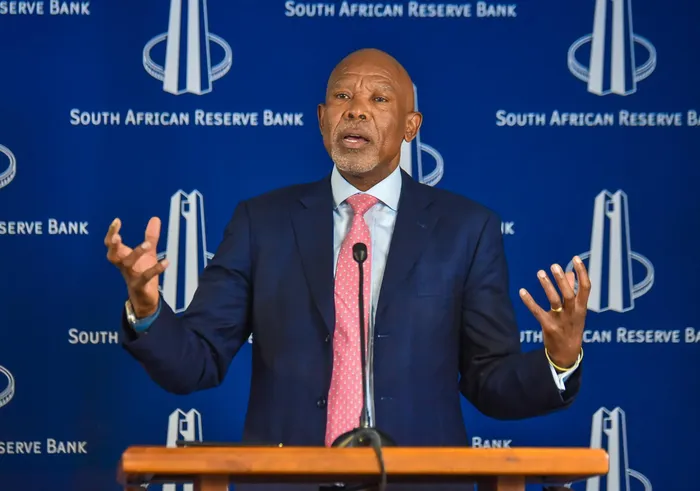Rate cut brings relief for consumers as Sarb signals confidence in long-term inflation outlook
INTEREST RATES

Sarb Governor Lesetja Kganyago on Thursday announced a 25 basis-point cut in the repo rate, bringing it down from 7.00% to 6.75% per annum in a unanimous decision, as the Monetary Policy Committee (MPC) signalled growing confidence in the inflation outlook and the broader economic environment.
Image: SARB | Facebook
South Africans will head into the festive season with welcome financial relief after the South African Reserve Bank (Sarb) cut interest rates by 25 basis points, reducing the repo rate from 7.00% to 6.75% per annum.
The unanimous decision by the Monetary Policy Committee (MPC) marks the sixth rate reduction since the start of the easing cycle in September 2024, bringing cumulative cuts to 1.75 percentage points.
The prime lending rate now falls to 10.25%, easing debt-servicing costs for households already strained by years of elevated borrowing rates.
Standard Bank’s Head of South Africa Macroeconomic Research, Dr Elna Moolman, said the full impact of the current cutting cycle will only be felt in 2026.
“This will then counteract the reduced tailwind from low inflation. Consumer spending will likely also be boosted by a wealth effect from stock market gains,” Moolman said.
“There will likely be further interest rate relief next year, but it cannot be taken for granted that this will be at consecutive meetings.”
Although headline inflation ticked up to 3.6% in October, from an average of 3% in the first half of the year, driven mainly by higher food and fuel prices, Sarb Governor Lesetja Kganyago stressed that these pressures are temporary and that inflation is expected to ease from early 2026.
“We remain on track to deliver 3% inflation over the medium term,” Kganyago said.
Recent data has come in slightly below the Sarb’s forecasts, helped by a stronger rand and lower oil prices. As a result, the Sarb made small downward revisions to its inflation projections for both 2025 and 2026. The bank remains confident of delivering 3% inflation over the medium term.
“Food price inflation seems to have peaked, although we have a small upward revision to this forecast, mainly from beef prices,” Kganyago said. “We assess the risks to the inflation outlook as balanced.”
Kganyago delivered the MPC statement against the backdrop of a turbulent global economy, where shifting trade patterns, divergent inflation paths among major economies, and an ongoing surge in artificial-intelligence-related investment have created pockets of financial vulnerability.
He also offered clarity on South Africa’s new inflation-targeting framework, announced last week.
The new target is 3% with a 1-percentage-point tolerance band on either side, replacing the long-standing 3–6% range.
Kganyago emphasised that the Sarb will aim squarely for 3%, rather than treating 2–4% as an acceptable range. However, because monetary policy operates with a lag, inflation will not always be exactly at the target. Deviations will be explained and policy will be set to guide inflation back toward 3% within a 12- to 24-month horizon.
“Accordingly, we want longer-run expectations to anchor at 3%, staying there even when there are shocks. This lag, between monetary policy decisions and outcomes, also explains why the 3% target is taking effect now, but will be achieved over the forecast period,” Kganyago said.
PPS Investments portfolio manager Reza Hendrickse said the rate cut strengthens the environment for risk assets.
“Lower borrowing costs should ease pressure on households and corporates, sustaining consumption and improving credit conditions,” Hendrickse said.
The Sarb’s commitment to a 3% inflation anchor signals a structurally lower rate environment over time, which could enhance valuations for equities and bonds.”
Domestically, Kganyago said South Africa’s growth outlook had stabilised and improved marginally, with better-than-expected economic activity in the second quarter and encouraging signals in the third.
The Sarb raised its growth forecast for 2025 to 1.3%, with growth projected to edge closer to 2% over the medium term. Employment has also continued to rise.
“Job-rich growth is now the high priority. The steadier growth outlook outlined by the MPC statement is being mainly driven by higher consumer spending, with fixed capital formation still lagging,” said Prof Raymond Parsons, North West University’s Business School economist.
“The cost of capital needs to be reduced. In the coming year a sufficient number of firms must feel that economic and political factors justify their fresh plans for expansion. Downside risks to export performance and growth from external tariff shocks also loom pending a new trade agreement with the US.”
BUSINESS REPORT